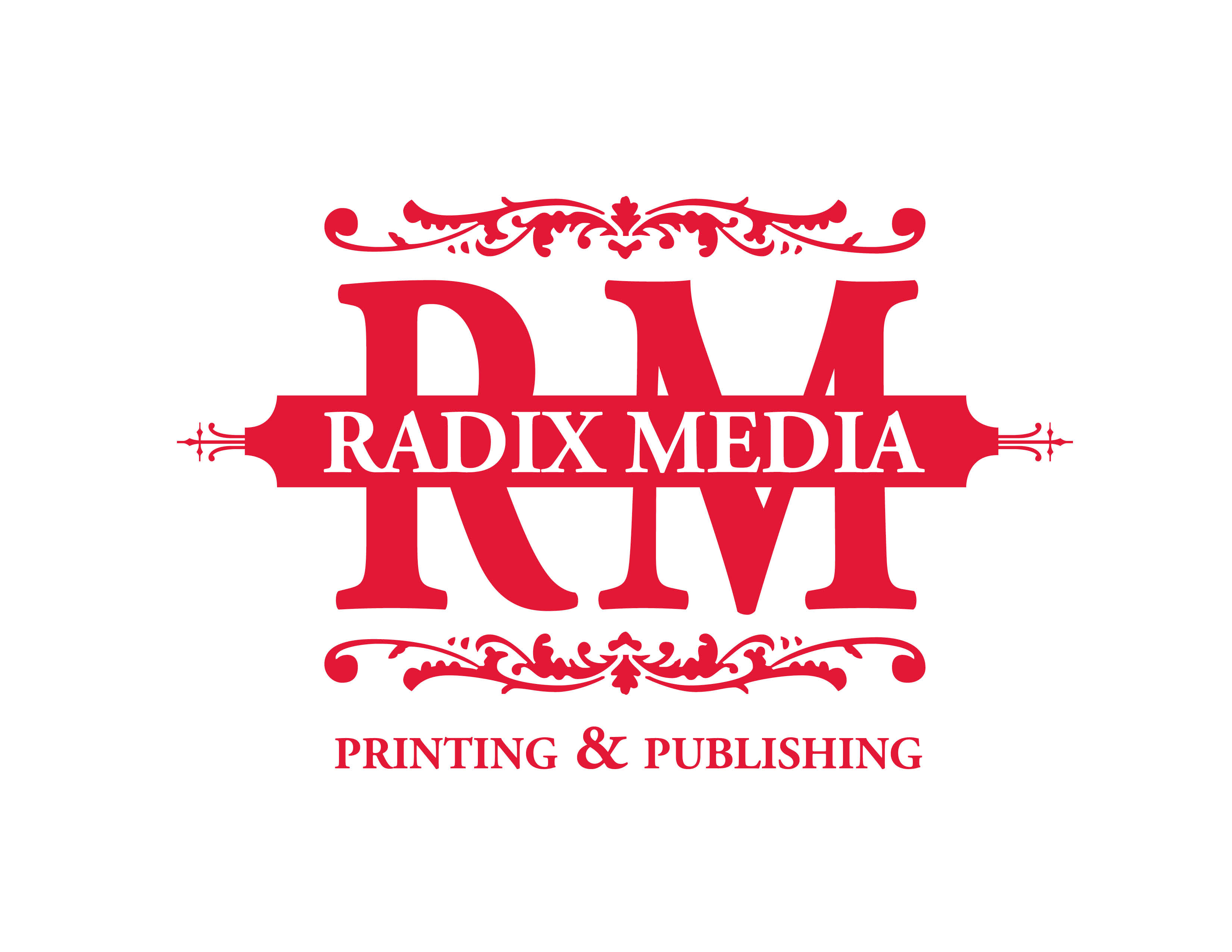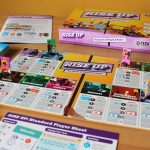ushwick Print Lab (BPL) is an artist-run screen printing studio, DIY space that hosts local events, and—if we’re being honest—a pillar of the New York City creative community. They offer commercial screen printing services for projects like shirts and fine art prints, as well as rent out space for printers to do their own work. They’ve worked with everyone from independent radical artists like Ganzeer and Justseeds to giants like the Guggenheim Museum. I had a long conversation with founder and director Ray Cross about the rich history of the shop, and the future of the trade.
For those who have never heard of you, introduce Bushwick Print Lab. How did it start?
Bushwick Print Lab started in October, 2009.
Previously, I had been working with Garrison Buxton and other collaborators, running the Ad Hoc Art gallery space at 49 Bogart Street and doing Peripheral Media Projects (PMP), a street art, design and silkscreen project that started out of a desire to circulate graphics in public space, that was first fostered by Adbusters Magazine around 2003. I moved to Brooklyn from Virginia, via a few years in Rochester, New York, in 2001 to go to Graduate School at Pratt Institute. I always loved school print shops, and was a student worker and shop assistant as much as possible, but seldom actually used screen printing in my work. I was mostly doing etching and some relief, and collagraph prints, but I teaching-assisted many silkscreen classes at Pratt. I also had a set of keys to the Pratt shop. Garrison and I wanted to put some political information about waste and consumption on the streets, and realized silkscreen was a fast and efficient way to make prints for wheat pasting. We knew that people were starting to pay attention to street art, and blogging about it. It was fun, interactive, low-stress and democratic at that time. There was a “fuck the big galleries, we will put up our art in the streets for everyone” vibe at that time at Pratt. We were spray stenciling and pasting stuff we had designed the night before. It was great. The Wooster Collective blog was growing exponentially—it was before Banksy really hit popular culture, before street art temporarily became the best way to start an art career. You could put art on the streets and see it the next day on the internet, viewed by thousands.
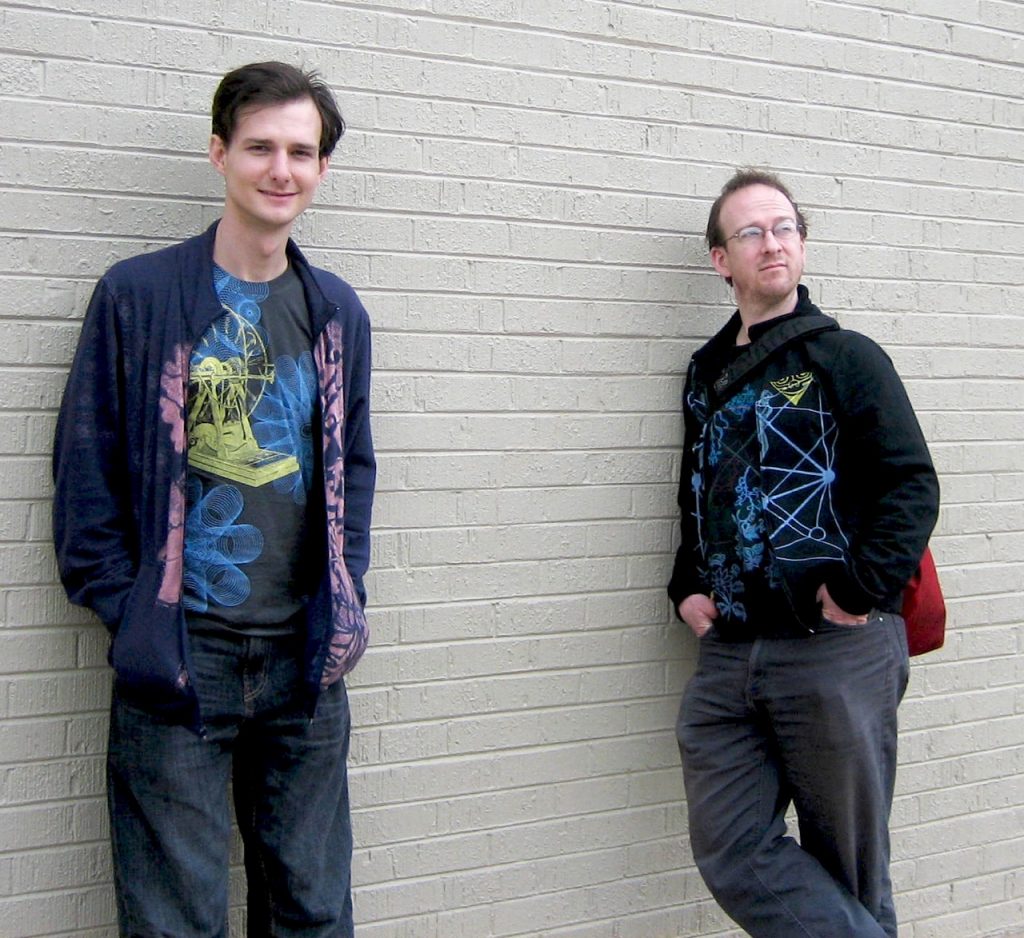 As grad school at Pratt was ending, I started working at Keenan Duffty, a punk-inspired fashion designer in SOHO as an apparel screen printer. They were printing shirts and everything else with no equipment, just a bunch of images on screens, a towel taped to a table as the work area, and water-based inks, washing them in their shower. They were selling them at high-end stores, so we thought, “if they can do it, so can we,” and we became apparel designers. We outgrew my apartment and moved to a commercial space at 49 Bogart Street in the East Williamsburg Industrial Park in 2004 or 2005. We had our production shop there, there were several small studios in the back, and we also ended up with a large room that became Ad Hoc Art Gallery. We produced screen printed design and art there as Peripheral Media Projects, did live silkscreen events, and became one of the first galleries with regular hours in Bushwick/East Williamsburg, alongside English Kills Gallery, and later Factory Fresh. That project started winding up in 2009. I was a minor partner in the business, but bought the silkscreen exposure unit from Garrison, so I could keep working, as I was printing some production work for clients, and silkscreen had become my main design medium during those years.
As grad school at Pratt was ending, I started working at Keenan Duffty, a punk-inspired fashion designer in SOHO as an apparel screen printer. They were printing shirts and everything else with no equipment, just a bunch of images on screens, a towel taped to a table as the work area, and water-based inks, washing them in their shower. They were selling them at high-end stores, so we thought, “if they can do it, so can we,” and we became apparel designers. We outgrew my apartment and moved to a commercial space at 49 Bogart Street in the East Williamsburg Industrial Park in 2004 or 2005. We had our production shop there, there were several small studios in the back, and we also ended up with a large room that became Ad Hoc Art Gallery. We produced screen printed design and art there as Peripheral Media Projects, did live silkscreen events, and became one of the first galleries with regular hours in Bushwick/East Williamsburg, alongside English Kills Gallery, and later Factory Fresh. That project started winding up in 2009. I was a minor partner in the business, but bought the silkscreen exposure unit from Garrison, so I could keep working, as I was printing some production work for clients, and silkscreen had become my main design medium during those years.
I moved in at 1717 Troutman Street in Ridgewood just as the building reopened for commercial tenants a year after a mass eviction of residential tenants by New York City authorities. I was sharing a space with friends from a Burning Man Camp called Image Node who did LED lighting design and tools for fire performers. At Ad Hoc we had done classes and workshops, and I wanted to continue the DIY accessibility of a community print lab, so I rented the space next door as Bushwick Print Lab, a publicly accessible space. That space opened to the public on December 17, 2009. As time passed my studio mates moved on to other things and I took over their share of the suite—it all became Bushwick Print Lab.
For years, even before the beginning of the project, in the PMP and Ad Hoc Art years, I was fairly poor. I had not figured out what business model of the screen printing industry I could fit into. Costs were high in NYC and profits on successful print jobs were low. I would just barely pay rent each month and started to carry a balance on my credit card. I had always taken advantage of any resources available, and when Peripheral Media Projects was working out of my apartment, we would use Pratt’s print lab to process our screens and would print films as 11″ x 17″ color laser prints, that we would simply expose to UV light for a very long time. A Pratt Alumni Card was $10 a year, and somehow entitled the holder to unlimited time in the computer labs and unlimited digital printing, so we printed our films and tiled them with Scotch tape and a Sharpie, if necessary. We would also print editions in the Pratt Lab in the late night, using all the drying racks for a large print run and leaving just before the first teachers rolled in at 8am. Then I would go to my day job.
Once, when going into my Pratt Computer Lab “office,” and passing through the Printmaking Department, I saw some adjunct faculty in the archive room. I asked what they were up to. They said they were “cleaning out the archive.” I went upstairs and plotted files for a few hours. When I walked out, I glanced at the dumpster that was outside the back door and saw two large foam core boxes. The boxes were full of prints. I looked at the prints and found that there were prints that students in my classes had given to the archive, there were prints that I had given to the archive. There were a lot of prints. I took the boxes out of the trash and took them home.
Years later, those prints ended up at Ad Hoc. We used to sell them around the winter holidays based on size ($5 Small, $10 Medium, $15 Large) splayed out on the obscenely large, eight section, red velvet couch that divided the space which we had gotten from someone working a production gig. Most were obviously student prints accumulated over the years. Some were amazing, technically virtuosic prints. Many were pretty old, from the 60’s, even. A few had printer’s chops embossed. I had pulled my favorites out of the pile and put them in a drawer at Ad Hoc. When the Ad Hoc Art project ended for me, I took the prints with me.
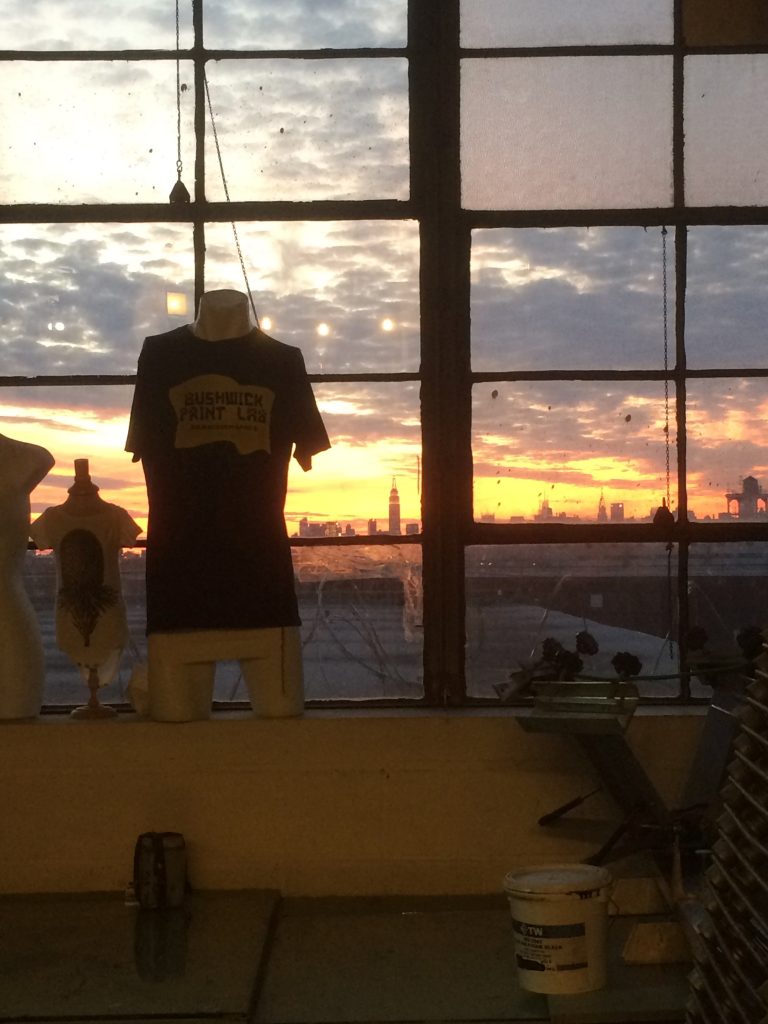 As Bushwick Print Lab was starting, I owed everyone money. Things were looking bleak. I started to research the prints from the 1960’s and realized that some were possibly valuable. It turns out there were quite a few from the Manhattan Graphics Center, a print facility that many international artists stopped through while in NYC, which was later integrated as part of Pratt Institute. There were three small AP prints with the printer’s chop ‘GEGO’ that would be forgettable, possibly, as student work without the chop (4″x4″ plate etchings of soft geometric studies), and they were all slightly damaged. A scratch in the plate area, a “smoke ring” from being displayed in a matte when everyone was smoking inside at Pratt in the 1970’s, some scuffing to the paper and bends in the corners. Our gallery director asked what I had as I was packing them to move out of Ad Hoc Art. I said, “I don’t know, this one says ‘GEGO’.” He immediately looked it up on ArtNet and said that her lithographs are selling for quite a lot of money. As BPL was beginning and struggling through our darkest hours, by some miracles and a good bit of hustling, I was able to sell those three AP’s for $14,000 to a Latin American art gallery on 57th Street. GEGO’s foundation authenticated the prints, Pratt administration miraculously signed off on the provenance of this dumpster score, I wore a black shirt and tie and carried the prints in a briefcase, and somehow it all worked out. Information on the artist, GEGO, aka Gertrud Louise Goldschmidt, is on Wikipedia. I used the money from the sale to pay back my many debts, buy some equipment and BPL’s first computer. There likely would not be a BPL if it was not for that dumpster dive. That is a really long-winded story, but I am telling it because the story underlines that everyone should ALWAYS LOOK IN THE TRASH. ALWAYS. People constantly throw away the most priceless things. Especially in New York.
As Bushwick Print Lab was starting, I owed everyone money. Things were looking bleak. I started to research the prints from the 1960’s and realized that some were possibly valuable. It turns out there were quite a few from the Manhattan Graphics Center, a print facility that many international artists stopped through while in NYC, which was later integrated as part of Pratt Institute. There were three small AP prints with the printer’s chop ‘GEGO’ that would be forgettable, possibly, as student work without the chop (4″x4″ plate etchings of soft geometric studies), and they were all slightly damaged. A scratch in the plate area, a “smoke ring” from being displayed in a matte when everyone was smoking inside at Pratt in the 1970’s, some scuffing to the paper and bends in the corners. Our gallery director asked what I had as I was packing them to move out of Ad Hoc Art. I said, “I don’t know, this one says ‘GEGO’.” He immediately looked it up on ArtNet and said that her lithographs are selling for quite a lot of money. As BPL was beginning and struggling through our darkest hours, by some miracles and a good bit of hustling, I was able to sell those three AP’s for $14,000 to a Latin American art gallery on 57th Street. GEGO’s foundation authenticated the prints, Pratt administration miraculously signed off on the provenance of this dumpster score, I wore a black shirt and tie and carried the prints in a briefcase, and somehow it all worked out. Information on the artist, GEGO, aka Gertrud Louise Goldschmidt, is on Wikipedia. I used the money from the sale to pay back my many debts, buy some equipment and BPL’s first computer. There likely would not be a BPL if it was not for that dumpster dive. That is a really long-winded story, but I am telling it because the story underlines that everyone should ALWAYS LOOK IN THE TRASH. ALWAYS. People constantly throw away the most priceless things. Especially in New York.
This is really a lot of backstory, but I feel it is important to look at where institutions actually come from. BPL came from some luck, a lot of practice of the craft, and an anarchist pirate ship of collaborators with good intentions. It keeps sailing forward because of those roots and our collective increase in becoming skilled screen printers that has only come from continual practice. So much trial and error, in every aspect of the business, but eventually you figure it out.
Since the early days, Bushwick Print Lab has had so many collaborators who have worked in the space, and worked tirelessly on improving, building and maintaining the space in a way that is useful to the general public. We have had an “hour for hour” work trade program since the start, and have a very talented staff who help to manage the space today. Some people have come to us to print a project or volunteer for a few hours and have stayed on in some capacity for years. I feel incredibly fortunate to have so many friends helping to move the project forward, keep the doors open, answer the emails, teach the workshops, fill the chemicals, pull the prints, and teach the basics, all while making their own great prints. The BPL has really become a print family and I am really proud of that.
“I feel it is important to look at where institutions actually come from. BPL came from some luck, a lot of practice of the craft, and an anarchist pirate ship of collaborators with good intentions.”
You’ve worked with some amazing artists and organizations. How have you cultivated those relationships since the BPL started in 2009?
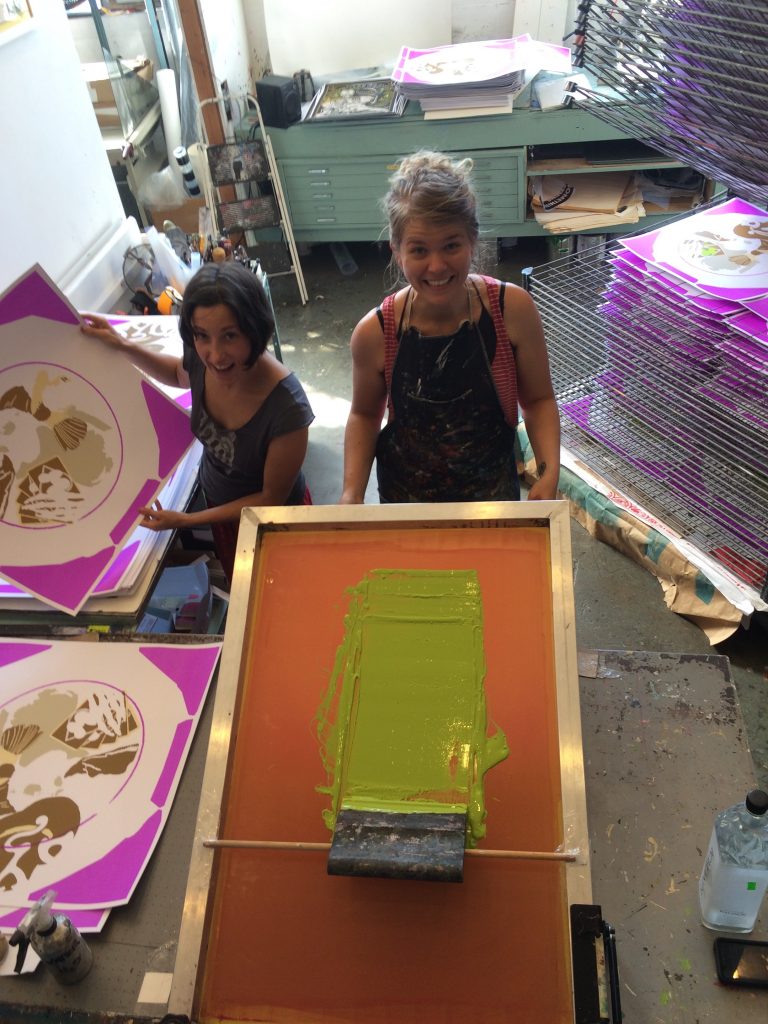 This is a great question. I always wonder how clients find us.
This is a great question. I always wonder how clients find us.
Generally, we will print anything that can be printed through a silkscreen, and are willing to try anything. We’re also a very affordable option, as opposed to the old-school print shops that have an established Blue Chip clientele. There are many apparel printers in NYC, and quite a few large format art printers—we will do the jobs that they won’t. We just want to make prints and get our assistants paid for their time. I feel that many clients who we work with today found us initially because we were the ones on the internet who would entertain their project, who really wanted to help them see it through to fruition, and we tried to get as close to their vision as possible.
We have always tried to prioritize the good work our friends have been doing, and have been fortunate to work with Justseeds, OWS, Interference Archive and so many populist organizations along with art world clients like John Giorno and many others who have collectively contributed to us being able to continue printing in our space. We always give special rates to local social and environmental organizations. We are lucky to work with the Newton Creek Alliance, Kingsland Wildflowers, BK Rot, Flex Program, House of Yes, Bushwig, and so many other neighborhood groups. I will say that it has been wonderful to see concerned younger citizens become wiser political players, actually intervening in local politics, and making great progress over these years in the various community efforts they are building. Many of the artists we work with have often come to BPL through original connections to graffiti and street art from the Ad Hoc Art days, and it is often a pleasure to collaborate with them on making prints, as well. I think most people trying to produce prints these days look online for the closest screen print place, and work outward from there. We try not to refuse them if they are new to the game, or if their project seems a little unusual, but honestly try to work it out for them. The first interactions may be challenging, but they continue to come back if you’re willing to put the time into the relationship.
Once the projects are running, you simply try to do your best to deliver and meet expectations. Sometimes you may fall short. Solve the problems and start again. Most clients are sympathetic. They want prints delivered, and we are here to facilitate the delivery of prints. It is a relationship that can be cultivated or squashed, depending on the approach.
As you know, Radix Media originally began on the west coast but merged with a small digital printing operation that came out of Occupy Wall Street after we relocated to New York. BPL also participated in Occupy. What was your experience with that and what’s changed since then?
The OWS printing was a whirlwind in our early days. We had long been in interaction with Josh MacPhee, Jesse Goldstein and Kevin Caplicki from Justseeds. Rae McGrath of Brooklynite Gallery was really excited about the Zuccotti Park occupation and asked if I would help do live silkscreen printing with him there after the first few weeks. I agreed, made some graphics, and did a live print on a Saturday. I left the screens there, and some of those images were incorporated into the OWS live printing machine and the OWS Guild. It was an amazing experience. Then I went back to BPL and back to work. A few of those images I made were printed hundreds or thousands of times by the volunteers and entered into the graphic culture of OWS, very much to my surprise. Much later, a version of the OWS design newspaper was shown in a wing of MOMA, and I was mentioned on a placard. Probably my first and last time having my name on a wall in MOMA. It was such an exciting time full of potential. Around half of the OWS printed portfolio project was printed at the BPL space, with other contributing printers from around the world. It was really beautiful to work with those friends to make something substantial, that seemed to be so important, at that time. It really felt like there was a sea shift, that we were winning, and that there was so much collective hope.
Now when I look back on that time, I mostly think that the people who pull the strings have engineered against a rupture like that happening again. Back then you could start a Facebook group, gather thousands of like minded members in a few days, have everyone in the world see the posts without paying a penny of “advertising dollars,” and let a movement grow organically without it being mined for promotion profits. It was a unique window of time for the internet. The OWS movement was unstoppable for a while. So much so, that it defeated all federal response times following Hurricane Sandy disaster around NYC. Citizens were engaged, resources were donated, volunteers stepped forward, and real relief was accomplished in a way that was so swift and accurate that it mocked bureaucratic responses. Anarchism at its best.
Today Facebook is a monetized hole. Besides a bunch of infighting amongst various parties, it seems nothing has really happened there since. The reason that’s sad is that Facebook was once such an amazing tool for real democratic organization.
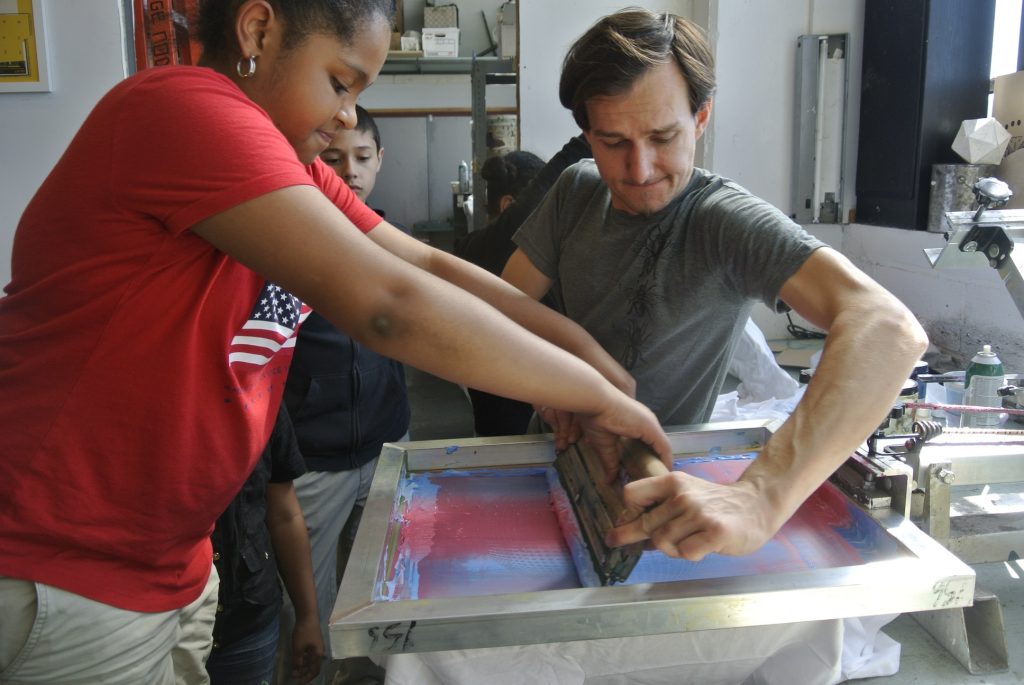 We keep screen printing for clients, but have done nothing so political, challenging, or fun since those days. Most often, truthfully, we work for the already successful, and do their brand bolstering. We still get to screen print, but there is not even the slight illusion that it may bring a more fair democracy. We have a great group of collaborators, and are beginning to look at the best way to structure the Bushwick Print Lab organization so that it is fair and everyone feels ownership, and that it still functions with personal responsibility, and can deliver the work our clients have come to expect, on the timelines they have come to expect. I see some restructuring coming in the future.
We keep screen printing for clients, but have done nothing so political, challenging, or fun since those days. Most often, truthfully, we work for the already successful, and do their brand bolstering. We still get to screen print, but there is not even the slight illusion that it may bring a more fair democracy. We have a great group of collaborators, and are beginning to look at the best way to structure the Bushwick Print Lab organization so that it is fair and everyone feels ownership, and that it still functions with personal responsibility, and can deliver the work our clients have come to expect, on the timelines they have come to expect. I see some restructuring coming in the future.
“[Occupy Wall Street] really felt like there was a sea shift, that we were winning, and that there was so much collective hope.”
You’re actually in Ridgewood nowadays. How has the city changed since the Bushwick days?
I was in East Williamsburg Industrial Park at 49 Bogart Street on the Morgan Stop for Peripheral Media Projects and Ad Hoc Art. That area is often called “Bushwick” but is really its own neighborhood, industrially designated by the City as East Williamsburg Industrial Park (EWIP).
When I started Bushwick Print Lab and opened to the public, it was in the current space, 1717 Troutman #203 and #204. We were always in Ridgewood, Queens, but were only four blocks from the Jefferson stop of the L Train. Not many people in greater New York City had thought much about Ridgewood, at that point. It was just a quiet, mostly Eastern European and Latino residential neighborhood. Having a Queens designation on our address somehow made everyone think we were in Long Island City. We were situated closest to Bushwick, and most of our friends and their projects were in Bushwick, so we went with “Bushwick Print Lab” as the name.
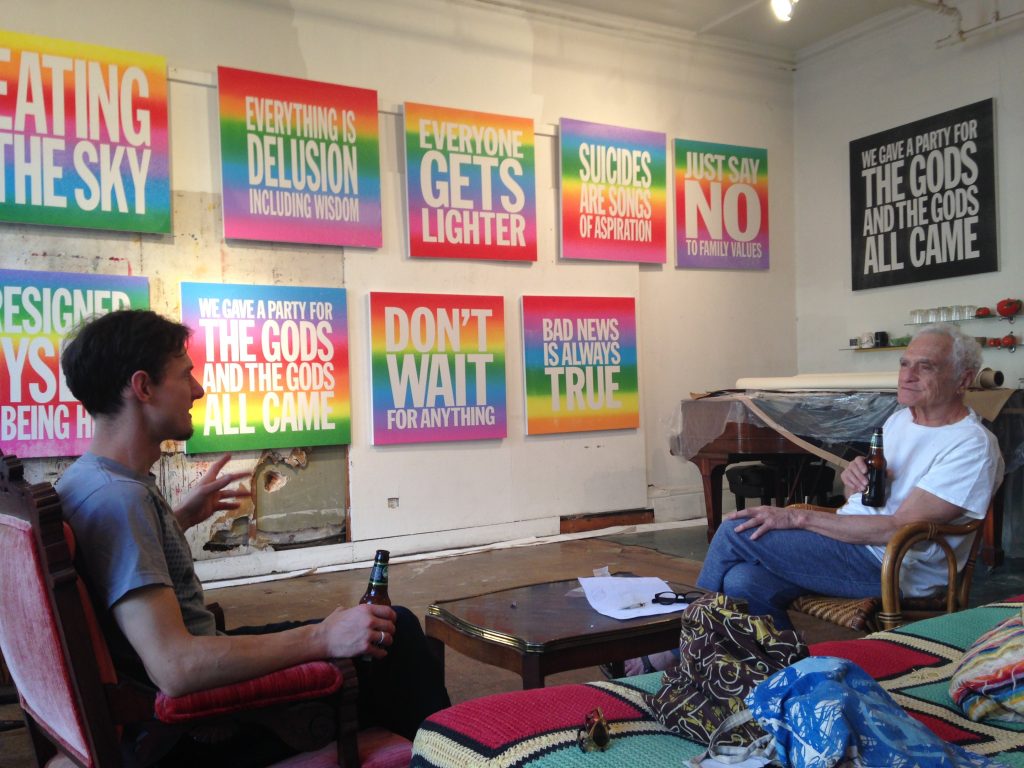 We are on the same block as the Onderdonk House, which is the oldest standing Dutch farm house in Brooklyn/Queens, built in 1709 by Paulus Vander Ende of Flatbush. It is actually the only other structure on the entire block, the rest is technically all 1717 Troutman Street. The entire visible area from our amazing roof deck is a post-industrial wasteland. Most of Brooklyn and Queens commercial and municipal trash processing is on Varick Avenue. The auto body shops of Flushing Avenue, the MTA’s bus depot, some large steel fabrication spots, Chinese import distribution warehouses, the trash tracks that transport NYC’s garbage by rail to welcoming landfills in neighboring states, the Maspeth and Greenpoint industrial parks. There is not a tree or anything green, except for the Onderdonk House and its small yard and gardens. The house was preserved in 1977 as a historical landmark site on the National Register of Historic Places by Greater Ridgewood Historical Society, which was formed to protect it from being razed for development in 1975 and raised money for its reconstruction from that time until 1981 when it was rebuilt after fire and neglect. It was a dividing line for the border of Bushwick, Brooklyn and Newtown Queens in semi-ancient borough history, and hosts Arbitration Rock on its grounds, which is said to be the former marker of the Brooklyn and Queens Division. Sometime later, in the 1970’s or 1980’s the few blocks where Bushwick Print Lab sits, which was previously considered part of Brooklyn, defected from the borough to join Queens, where the property values were relatively higher. That puts us back into Queens, 11385, apparently, but the far extreme leg of the area. Our official receiving post office is 1.6 miles away, but the closest Brooklyn post office is less than half a mile from the Lab. Existing on a border is always a little weird.
We are on the same block as the Onderdonk House, which is the oldest standing Dutch farm house in Brooklyn/Queens, built in 1709 by Paulus Vander Ende of Flatbush. It is actually the only other structure on the entire block, the rest is technically all 1717 Troutman Street. The entire visible area from our amazing roof deck is a post-industrial wasteland. Most of Brooklyn and Queens commercial and municipal trash processing is on Varick Avenue. The auto body shops of Flushing Avenue, the MTA’s bus depot, some large steel fabrication spots, Chinese import distribution warehouses, the trash tracks that transport NYC’s garbage by rail to welcoming landfills in neighboring states, the Maspeth and Greenpoint industrial parks. There is not a tree or anything green, except for the Onderdonk House and its small yard and gardens. The house was preserved in 1977 as a historical landmark site on the National Register of Historic Places by Greater Ridgewood Historical Society, which was formed to protect it from being razed for development in 1975 and raised money for its reconstruction from that time until 1981 when it was rebuilt after fire and neglect. It was a dividing line for the border of Bushwick, Brooklyn and Newtown Queens in semi-ancient borough history, and hosts Arbitration Rock on its grounds, which is said to be the former marker of the Brooklyn and Queens Division. Sometime later, in the 1970’s or 1980’s the few blocks where Bushwick Print Lab sits, which was previously considered part of Brooklyn, defected from the borough to join Queens, where the property values were relatively higher. That puts us back into Queens, 11385, apparently, but the far extreme leg of the area. Our official receiving post office is 1.6 miles away, but the closest Brooklyn post office is less than half a mile from the Lab. Existing on a border is always a little weird.
All that said, NYC has changed immensely in the last decade. Bushwick has changed exponentially in that time, as well. In New York City in general, relative safety and order after the 1980’s has caused incredible speculation and development. This is immediately obvious in Manhattan. In the mid 2000’s it reached Williamsburg. By 2015 most artists and institutions that were not immediately financially rewarded began to be pushed further down the L Line. When Ad Hoc Art started on the Morgan Avenue stop there was not much consumer comfort there. Just real industry and work, and creatives looking to be as thrifty as possible in New York while living the “art life.” People often called the gallery and said, “My friend has work in a show that is opening out there. I was there several years ago. Will I get stabbed if I come to your opening?” For whatever reason, it used to be the area of NYC where you took a car and burned it. That area got relatively safer, and relatively more expensive. The space and PMP and AHA project became untenable at a point.
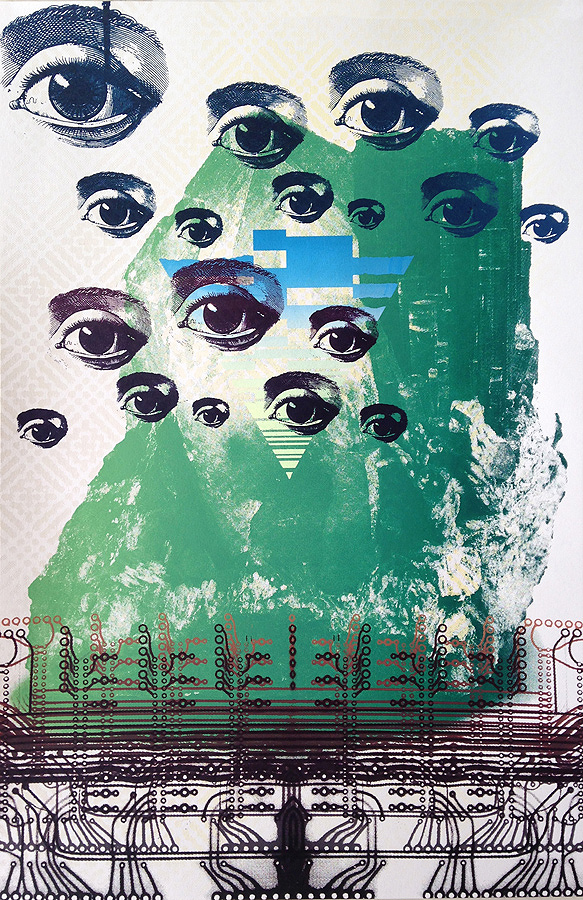 When I moved to the Jefferson Avenue stop in 2009, there were also not many creature comforts. Bushwick was a notoriously low-income area after the riots, white-flight, and landlord arson in the late 1970’s. In the immediate area, North East Kingdom was the oldest farm-to-table eatery, Bodega Bar was there. The rest was warehouse space, sweatshops, and largely abandoned properties. In 2014 we were walking down Troutman Street and it was like watching a race to see who could change an auto-body repair shop into a swanky restaurant the fastest, behind a green construction barricade. The Hana Natural opened and the rest is history. Now Jefferson has become the club and venue district of Brooklyn. The street art of the Bushwick Collective Project has helped drive development, ensuring everyone knew it was an edgy, artsy neighborhood, full of murals and creatives, where they could take great selfies. There are many tours of the murals offered by different guides each day. Bushwick is a case study in recent hyper-development. As early commercial tenants, our rents have increased slowly and steadily over the past nine years. Artist space is in high demand now. Having two separate studio spaces, combined as one unit, has not helped our cost per square foot of work space ratio.
When I moved to the Jefferson Avenue stop in 2009, there were also not many creature comforts. Bushwick was a notoriously low-income area after the riots, white-flight, and landlord arson in the late 1970’s. In the immediate area, North East Kingdom was the oldest farm-to-table eatery, Bodega Bar was there. The rest was warehouse space, sweatshops, and largely abandoned properties. In 2014 we were walking down Troutman Street and it was like watching a race to see who could change an auto-body repair shop into a swanky restaurant the fastest, behind a green construction barricade. The Hana Natural opened and the rest is history. Now Jefferson has become the club and venue district of Brooklyn. The street art of the Bushwick Collective Project has helped drive development, ensuring everyone knew it was an edgy, artsy neighborhood, full of murals and creatives, where they could take great selfies. There are many tours of the murals offered by different guides each day. Bushwick is a case study in recent hyper-development. As early commercial tenants, our rents have increased slowly and steadily over the past nine years. Artist space is in high demand now. Having two separate studio spaces, combined as one unit, has not helped our cost per square foot of work space ratio.
Displacement of previous residents by new college-educated creatives in Bushwick is among the highest in all NYC neighborhoods, as is landlord fraud for rent stabilized apartments. There seems to be a huge over-valuing of properties in Bushwick, but perhaps it is the whole city, these days. We are looking at other options for our space, and can only hope that the 15 month closure of the L Train in Spring will bring some reality to the real estate game here.
I love East Williamsburg/Bushwick/Ridgewood and most of my clients, creative friends and associates are here. I have lived my working life here, publicly, for the past fifteen years. I am doing my best to work out a long-term arrangement now, for the future of BPL, while the prospect of a transit catastrophe is the best leverage we have, collectively.
What is it about screen printing—as opposed to other printing processes—that’s kept you in love all these years?
When I first silkscreened it was part of a three section “Intro to Printmaking” class in 1994, at VCU, with aluminum plate litho, etching and silkscreen. I hated it. Everything had to be black and white to set up the art. I was really into etching and mono-printing and all the subtle grays. I loved the materials, the deep acid bites, the process, the time traces.
When I started using screen printing as my main medium of design with Peripheral Media Projects, it was because it was fast and direct. The scale could be large, and a great graphic image would reproduce impeccably. It was incredibly immediate, and very cheap in terms of the materials needed, and the matrix, the screen was infinitely re-usable. We were just trying to make square footage of art prints to compete with commercial advertising on the streets at first. We figured if we made more interesting images and occupied the same space as advertising, we would win. Screen printing was the fastest way to make a print. Once the graphic image was on a screen, making hundreds of copies only took a few hours. It is a very graphic medium, then it became a game to “crate dig” interesting images to caption from the dust-bin of history, and how to combine them to make it interesting for the viewer. I think of myself as an image collagist and re-mixer more than a “master printer.”
Fine Artists seem to have this dream where they exist in hyper-color, all possibilities are open. Infinite choice. All the colors in the rainbow on every facet.
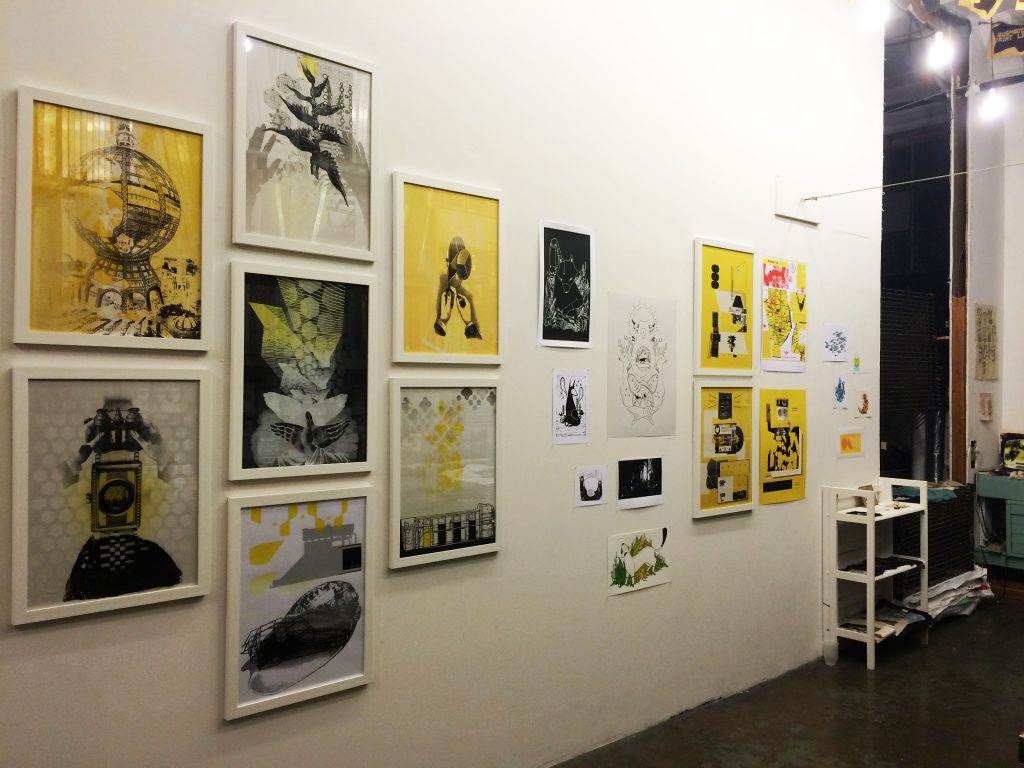 I really enjoy screen printing for the science, math and the limitation. Every layer of print has to be reduced to black and white. Every single pixel or mesh opening is black or white, open or blocked. It is like taking something so rich as life experience and reducing it to polar opposites. But limitation in art produces amazing results. A limitless array of possibilities are still present with transparency, layers, ink color, density, materials, the beautiful subtlety of a split-fountain of ink.
I really enjoy screen printing for the science, math and the limitation. Every layer of print has to be reduced to black and white. Every single pixel or mesh opening is black or white, open or blocked. It is like taking something so rich as life experience and reducing it to polar opposites. But limitation in art produces amazing results. A limitless array of possibilities are still present with transparency, layers, ink color, density, materials, the beautiful subtlety of a split-fountain of ink.
The screen print process is so simple, compared to others. You have some holes in a thing, you push ink through those holes in the thing, ink goes onto whatever is below the thing, ink does not go where there are not holes in the thing. The simplest print process of all!
Screen printing can happen in any ink system on any surface, whatever can be made flat enough to print—paper, textiles, a wood block, a guitar pedal, a metal tin, a road case, someone’s back. You can even do cylinders, like bottles, if you roll them. All you have to do is put ink through a hole and get it to stay where you have put it.
It is devilishly simple but there are so many complexities. After all these years I do tons of online research and learn form my peers all the time. It is a great, immediately rewarding print medium to explore. I don’t think any creative person has ever regretted taking some time and effort to learn to be an adequate silkscreen printer.
“I really enjoy screenprinting for the science, math and the limitation. Every layer of print has to be reduced to black and white. Every single pixel or mesh opening is black or white, open or blocked. It is like taking something so rich as life experience and reducing it to polar opposites.”
In the past decade, there have been many times when offset printing, or even print in general, has been “dead.” Where do you see screen printing as a trade ten years from now?
I actually think print and physical media are in a great place, currently. Print media is perhaps the most un-dead it has ever been. As the world becomes more cold and digital, and everyone’s life is spent watching light gloss over a digital screen, our job as printmakers gets both easier and better.
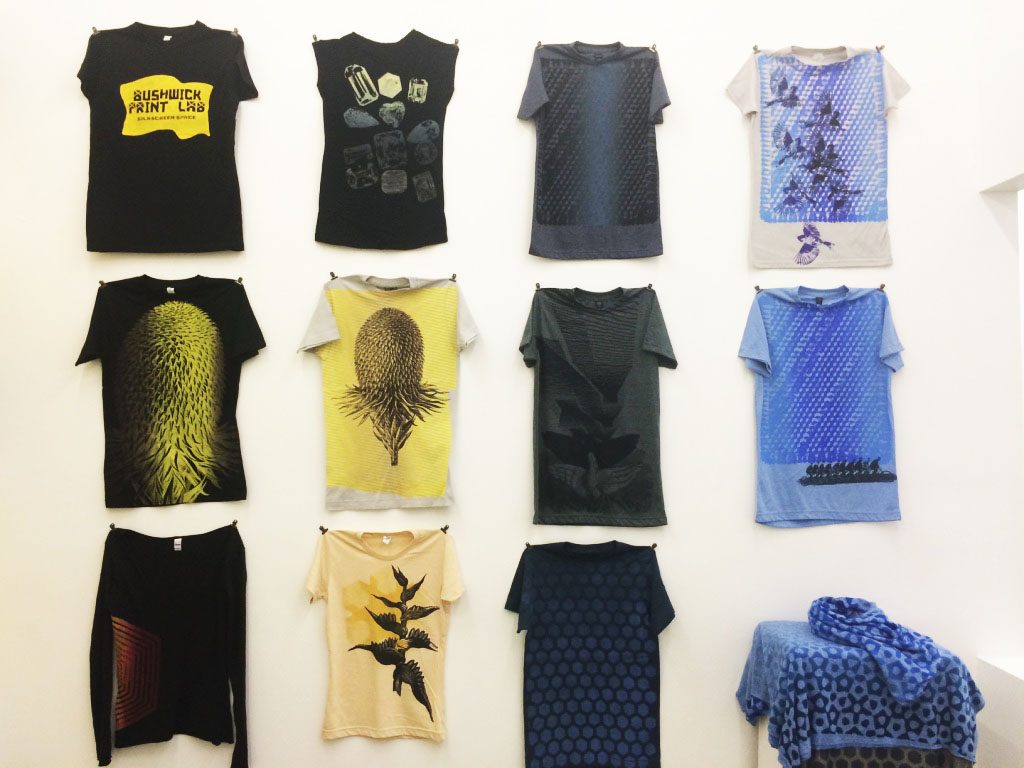 I have a minor in textiles from my undergrad days, and remember Suzi Gablik, and other handmade textile artists stressing that as the world becomes colder, appreciation for the warm, handmade and tactile will grow among fans of art and culture. Today, we are more or less at an apex for the cold, digital feed we experience constantly. More so than we could have imagined ten years ago.
I have a minor in textiles from my undergrad days, and remember Suzi Gablik, and other handmade textile artists stressing that as the world becomes colder, appreciation for the warm, handmade and tactile will grow among fans of art and culture. Today, we are more or less at an apex for the cold, digital feed we experience constantly. More so than we could have imagined ten years ago.
There is something great about physical product, something you can hold in your hands, the more haptic the better. Old-school print of all kinds provides that sensation. We have seen Seamless ads plastered on the NYC subway, attempting to copy—poorly—the aesthetic of badly printed offset prints. It’s so much better to have a human pulling a hand-inked print.
Ten year from now, in silkscreen, I see a myriad of small designers playing with the boundaries of the medium, making great design and art, and distributing it affordably to a global mass audience. I think it is analogous to vinyl records. In a digital age, vinyl should be dead, but releases on vinyl sell out fast, and there is a place for printmakers and designers in that process. Trends are always a pendulum. The kids today love Risograph and other arcane print technology. Simple offset printing is probably the next “trashed” technology to be rediscovered. Small press book binding seems to be on the rise. It is really an exciting time for old print technology. We are happy to support the trend.
How can people support Bushwick Print Lab?
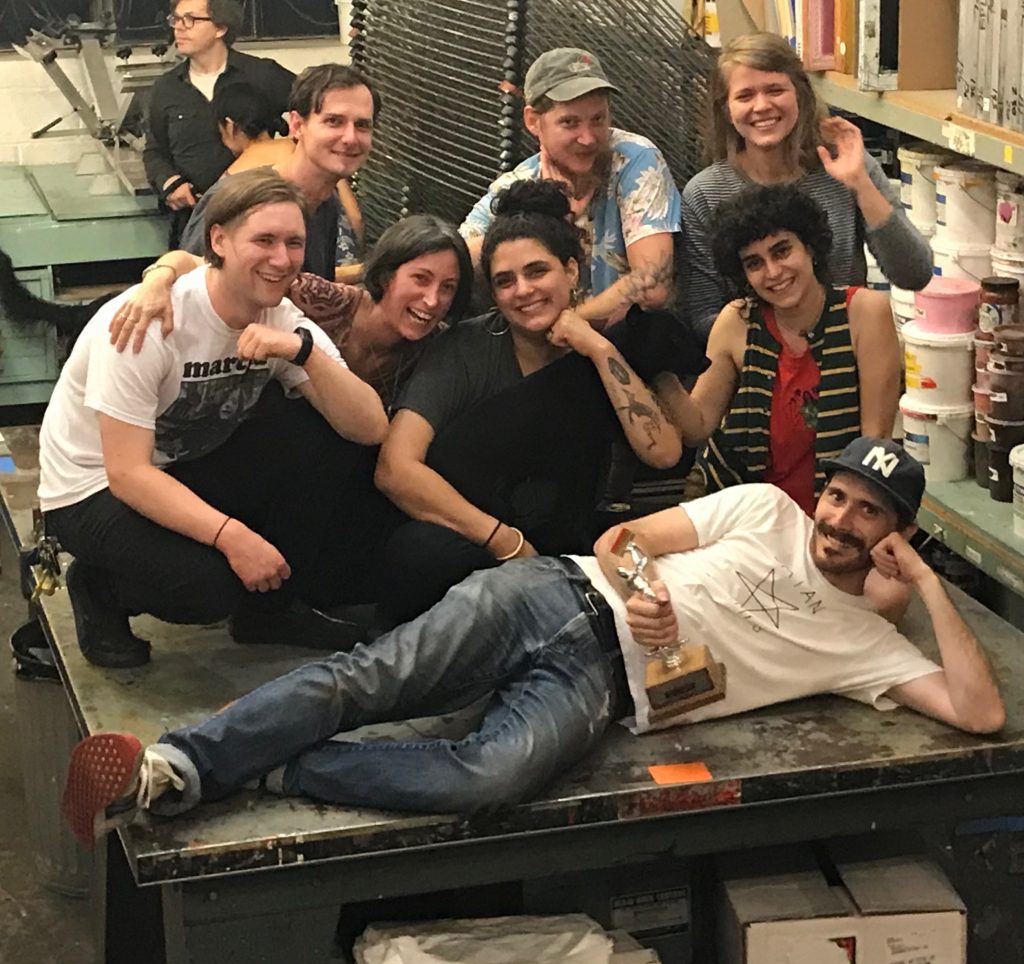 People can support us by becoming involved with our space and the artists we collaborate with.
People can support us by becoming involved with our space and the artists we collaborate with.
Take a workshop, buy a print from an edition we have published, produce a screen print with us, have us quote the project your company is trying to run, contact us about live printing your event.
The best contact is through our website at www.bushwickprintlab.org and via email at info@bushwickprintlab.org.
We are finally launching our web store, full of short run apparel and paper prints by BPL artists. There’s lots to browse and even more to come.
Come to one of our many events or workshops, you can sign on to our mailing list here to receive more info: http://bushwickprintlab.org/contact/
Follow us on Instagram: https://www.instagram.com/bushwickprintlab/ or @bushwickprintlab
Community Spotlight is a blog series that seeks to connect people and build power. Each post will feature a person or organization doing great work in their community and fighting for a more just world. We interview writers, illustrators, podcasters, filmmakers, activists, and more. Subscribe today and let’s start building together.
